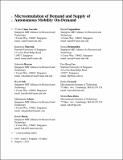Microsimulation of Demand and Supply of Autonomous Mobility On Demand
Author(s)
Azevedo, Carlos Lima; Marczuk, Katarzyna; Raveau, Sebastián; Soh, Harold; Adnan, Muhammad; Basak, Kakali; Loganathan, Harish; Deshmunkh, Neeraj; Lee, Der-Horng; Frazzoli, Emilio; Ben-Akiva, Moshe; Ben-Akiva, Moshe E; ... Show more Show less
DownloadMicrosimulation of demand.pdf (1.908Mb)
OPEN_ACCESS_POLICY
Open Access Policy
Creative Commons Attribution-Noncommercial-Share Alike
Terms of use
Metadata
Show full item recordAbstract
Agent-based models have gained wide acceptance in transportation planning because with increasing computational power, large-scale people-centric mobility simulations are possible. Several modeling efforts have been reported in the literature on the demand side (with sophisticated activity-based models that focus on an individual’s day activity patterns) and on the supply side (with detailed representation of network dynamics through simulation-based dynamic traffic assignment models). This paper proposes an extension to a state-of-the-art integrated agent-based demand and supply model—SimMobility—for the design and evaluation of autonomous vehicle systems. SimMobility integrates various mobility-sensitive behavioral models in a multiple time-scale structure comprising three simulation levels: (a) a long-term level that captures land use and economic activity, with special emphasis on accessibility; (b) a midterm level that handles agents’ activities and travel patterns; and (c) a short-term level that simulates movement of agents, operational systems, and decisions at a microscopic granularity. In that context, this paper proposes several extensions at the short-term and midterm levels to model and simulate autonomous vehicle systems and their effects on travel behavior. To showcase these features, the first-cut results of a hypothetical on-demand service with autonomous vehicles in a car-restricted zone of Singapore are presented. SimMobility was successfully used in an integrated manner to test and assess the performance of different autonomous vehicle fleet sizes and parking station configurations and to uncover changes in individual mobility patterns, specifically in regard to modal shares, routes, and destinations.
Date issued
2016-01Department
Massachusetts Institute of Technology. Department of Civil and Environmental Engineering; Singapore-MIT Alliance in Research and Technology (SMART)Journal
Transportation Research Record: Journal of the Transportation Research Board
Publisher
Transportation Research Board of the National Academies
Citation
Azevedo, Carlos Lima; Marczuk, Katarzyna; Raveau, Sebasti?n; Soh, Harold; Adnan, Muhammad; Basak, Kakali; Loganathan, Harish et al. “Microsimulation of Demand and Supply of Autonomous Mobility On Demand.” Transportation Research Record: Journal of the Transportation Research Board 2564 (January 2016): 21–30
Version: Author's final manuscript
ISSN
0361-1981